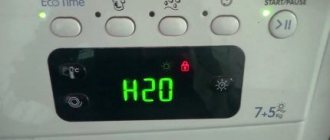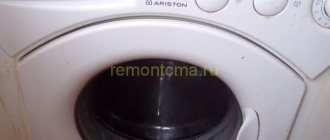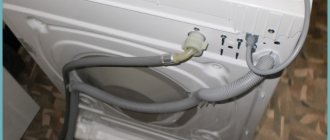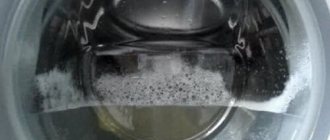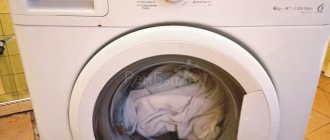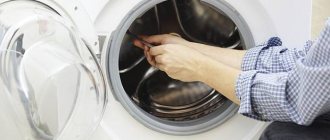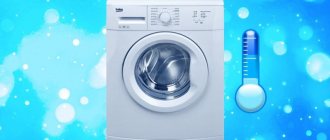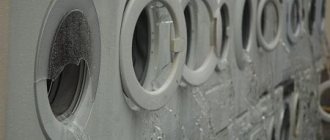- home
- Articles
- The turned off washing machine draws water
Why does the washing machine fill with water when it is turned off and is it possible to eliminate such a nuisance? This question worries many users, because such a phenomenon can lead to a flood, from which not only you, but also your neighbors below will suffer. In fact, figuring out this situation is quite simple - just follow the tips described in this post.
What does this mean?
According to the instructions for the washing machine, its internal elements must be kept dry between washes. First of all, this applies to the drum where dirty things are loaded.
If the washing machine fills with water when it is turned off, this can lead to the following problems:
- the spread of an unpleasant odor in the room where the machine is installed;
- the formation of fungus and mold on the inner walls of the drum;
- gradual rusting of the metal elements of the device;
- danger of water pouring out of the washing machine onto the floor of the apartment.
Based on this, it is necessary to take this problem seriously and make every effort to eliminate it.
Video
Problems in the operation of household appliances arise unexpectedly. If the owner is not confident in his own strengths and competence, he can turn to specialists for help. In the event that you want to independently understand the causes of the breakdown and eliminate it, the recommendations of professionals will help.
Water fills into the washing machine when it is turned off only if the drain or water valve is faulty. The drain system needs to be cleaned and the valve replaced. And the washing machine will work properly again.
Where does the water come from when the washing machine is turned off?
There are two sources from which water can get into the washing machine drum:
- Sewer system. It is quite easy to recognize such a liquid by its unpleasant odor and dirty appearance. This usually happens with units whose drain is connected to the siphon of a nearby sink.
- Water pipe. In this case, we are talking about clean water seeping through the inlet valve. To check, you need to turn off the tap on the supply hose: the flow of water into the drum should then stop.
Precautionary measures
The following recommendations should be followed to ensure that the washing machine is in good working order in the future and does not fill with water spontaneously.
| Your actions | Result |
| Manually close the water supply valve. | This will allow the valve to last longer and prevent water from refilling. |
| Install a check valve that will act as a barrier to sewer fluid. | Sewage water will no longer enter the machine. |
| Use the automatic system. | It will protect against leaks. |
The main thing: operate the machine according to the rules, follow the instructions and treat the equipment with care. And it will serve the owner for a long time.
Methods for troubleshooting
Having discovered that the switched off washing machine is drawing water, you must immediately close the supply tap. If this is not done, the liquid will eventually begin to pour out of the drum onto the floor. Actions to eliminate the malfunction depend on its nature.
Water comes from the sewer
The reason why wastewater gets inside the washing device is usually an error in the drainage system. Therefore, it is strongly recommended that you strictly follow the manufacturer’s recommendations when installing a household appliance.
Why does sewer water end up in the washing machine drum?
- Poor location of the drain hose . This applies to situations where the drain occurs directly into the bathtub or sink. It is necessary to ensure that the end of the elastic tube is located below the level of the drum and is not immersed in water.
- There is a blockage in the tube. In this case, the waste water simply cannot come out. All you need to do is clean the hose.
- The siphon to which the unit is connected is clogged. This will also be indicated by stagnation of water inside the sink. Washing the siphon is quite simple: the main thing is to carefully unscrew its flask.
To avoid a situation where, when the siphon is clogged, water from the sink begins to move into the washing machine drum, it is recommended to use a siphon valve. It is designed in such a way that it allows fluid to flow in only one direction (in this case, away from the car).
Water comes from the water supply
There is only one reason for this malfunction - failure of the water supply solenoid valve. This type of device cannot be repaired - it only needs to be changed.
Situations that can cause intake valve failure:
- The presence of a large amount of mechanical impurities in the water. The solution is to install dirt filters on the pipes.
- Valve wear. Like any other device, it has a service life.
- Faulty wiring inside the washing machine. A short circuit can cause spontaneous operation of the valve.
What to do to change the intake valve yourself:
- Disconnect the appliance and turn off the water supply.
- Rotate the machine so that direct access to the rear of the body is provided.
- Unscrew the supply hose and remove the top cover.
- Find the valve. It is usually installed immediately behind the supply tube.
- Dismantle the valve, disconnecting it from the tubes and wires.
- Install a new device by connecting all tubes and wiring to it in the correct polarity. To make the procedure easier, it is recommended to photograph the supply lines before dismantling the old valve.
There are several models of intake valves. To purchase the right model, the easiest way is to go to a specialized store along with the broken device.
Water appears when the unit is operating
When parts of the drain system break, partial drainage occurs. Sometimes the liquid does not drain at all and remains in the drum.
The drain filter is clogged
The wash is finished, but there is still liquid in the centrifuge. This problem occurs due to a clogged drain filter. Sometimes small parts in the form of coins, paper clips and buttons get into it.
To clean it, you need to:
- Drain the liquid in the hose.
- Unscrew the filter. To do this, the cover located at the bottom of the body is removed, the part is unscrewed and washed.
- Check the pump located behind the filter for clogging. To do this, you need to start the drain mode. The pump blades should rotate freely. If their movements are difficult, then the pump is clogged with dirt and should be cleaned.
- Insert the filter back and turn on the drain function. If the reason was a contaminated drain, then the system should be fully operational.
Read more ► The structure of an automatic washing machine: principle of operation, what it consists of
Broken pump
The blockage creates a favorable environment for the emergence of microbes and an unpleasant odor.
The machine makes a lot of noise and tries to drain the liquid, but to no avail. The pump may be broken or clogged with dirt.
You can check its operation as follows:
- Remove the filter and inspect the pump for dirt.
- If no dirt is found, turn on the drain mode.
- The pump blades should rotate. If this does not happen, a major overhaul is necessary.
To repair a part, you need to call a technician who will replace the broken part with a new one. The load on the pump increases when the drain hose is artificially lengthened.
How to avoid trouble
To prevent situations when the washing machine draws water when it is turned off, it is recommended to perform several simple procedures:
- Screw in the shut-off valve after turning off the washing machine. Otherwise, pressure from tap water will constantly be applied to the inlet valve membrane. As a result, the service life of the device will be noticeably reduced. In cases where the supply hose is not equipped with a shut-off valve at all, this situation must be corrected immediately.
- Equip the siphon to which the drain hose is connected with a check valve. Thanks to this, the washing machine will receive additional protection against waste water entering its drum.
- Install a shut-off valve between the siphon and the drain hose. By closing it after finishing washing, you don’t have to worry about clogging or breaking the siphon. The main thing is not to forget to open the valve before turning it on.
- Install a special anti-leak system that reacts to the appearance of moisture on the floor of the room. The Aquastop function inside the washing machine will not help in a situation where water enters a de-energized appliance. The fact is that the sensors of the built-in system are located inside the pan of the machine, and water from an overfilled drum usually flows directly onto the floor.
Situations when a washing machine that is turned off takes in water are rare, but they do occur. In this case, there is no need to panic: the most you have to do is change the intake valve.
What to do
Once you have determined where the water in the disabled washing machine came from, it’s time to move on to action to eliminate the problem. But what is the best thing to do: call a specialist or try to fix everything on your own?
- If water comes from the sewer, then the reason is either a blockage or an incorrect connection of the drain to the sewer. In principle, anyone can remove the blockage on their own. Getting the drain out correctly is a more difficult task. If you cannot cope with it on your own, then you can use the service of professional installation of washing machines.
- If water enters the washing machine due to a faulty inlet valve , you can, of course, try to replace it yourself. However, this is a very risky undertaking, especially if you are going to change the valve for the first time. Therefore, you should not experiment - it’s better to call a specialist. In the meantime, you are waiting for him to arrive, just turn off the water supply valve to the machine.
Important for those whose washing machine is under warranty! You should be aware that the manufacturer's warranty does not cover problems caused by improper connection of the washing machine to the sewer. Therefore, in this case, there is no point in calling the warranty service center; they will refuse you free repairs.
Why does the washing machine take up water on its own?
How did liquid appear in the disconnected equipment? There are two options - from the sewer or water supply. It is not difficult to determine this by color and smell. It’s good if you immediately discovered the problem, but it also happens that water enters the machine when the owner is at work. Then you can find a whole flood at home. Therefore, experts recommend closing the inlet valve after each wash.
The Aquastop system will not protect against leakage. The sensor is located in the tray, and the water flows directly into the drum, after which it is poured onto the floor.
What is the cause of the malfunction:
- the intake valve is broken;
- clogged or incorrectly connected drain.
Remember that the warranty does not apply in cases where the user independently connected the equipment to the water supply. You can use warranty services if the installation of communications was carried out by a master, after which a leak occurred.
Clearing the blockage
Most often, a disconnected machine is filled with liquid from the sewer when the hose is connected to the siphon. If clogged, the device does not function properly, allowing water to flow into the washer tank. Do this:
- Close the inlet valve.
- Disconnect the drain hose.
- Check the siphon and remove the blockage.
Debris can be removed manually or using special means. After this, run a short cycle with hot water to clean the drum and check the operation of the washer.
If the problem is not a blockage, then make sure the connection is correct. Inspect the communications and make sure the hose is positioned correctly. To prevent water from filling in and draining on its own, the end of the hose should be at a distance of 50 cm - 1 m from the floor. Then the pump will function normally and drive liquid into the sewer.
Replacing the solenoid valve
The inlet or solenoid valve is located immediately behind the water supply hose, at the top of the front machine. On top-loading models, the part may be located behind the side wall. When the equipment is off, the valve is closed. As soon as the washing machine starts, current flows to the valve contacts and the damper opens, letting water into the tank.
As soon as the current supply stops, the damper closes and washing begins. Often the valve operates as a characteristic click. If the element breaks, the damper does not operate at all. Then, even when turned off, the machine draws water.
What to do? First of all, close the inlet valve and turn off the power to the washing machine. Turn the equipment with its convenient side facing you. Next follow the instructions:
- Remove the two bolts from the back and remove the top cover from the housing.
- There are usually two hoses leading to the valve. In some SMA models, the part is covered with a powder cuvette.
- Unclench the clamps and disconnect the hoses.
- Disconnect the wiring.
- Unscrew the fastening bolts.
A broken element cannot be repaired. A multimeter will help you make sure it's working properly. Attach the tester probes to the valve contacts and look at the display. The working part will show a result of 3 kOhm.
Select a similar part and install in reverse order. Do not rush to replace the machine cover. Turn on the test cycle and check the operation of the part in action.
The video shows how to replace the valve:
How to avoid leaks?
Finding a puddle on the floor is unpleasant, especially when you have to pay for the repairs to your neighbors. To avoid such situations, do this:
- After each wash, close the inlet valve.
- Use an anti-siphon valve to prevent dirty liquid from entering the drum.
- Install full leakage protection. It includes sensors on the floor that will trigger if there is a leak.
Use proven methods so as not to repeat the mistakes of others. It is better to take care of safety in advance than to eliminate the consequences later.
Control block
In a modern automatic washing machine, all components are controlled by an electronic module, which is essentially a computer with software. If the valve circuit is damaged, the controller does not turn them off and water is constantly drawn in.
In this case, two options are possible:
It is not always possible to find a new module that matches the SMA model. Sometimes you need to wait 2-3 months. In addition, it needs to be flashed with a program. He won't work without it. It's like a computer without Windows.
For restoration, it is best to contact a specialized washing machine repair service.
SMA control module
Let us note right away that this breakdown is not typical for any particular brand, but is inherent in all SMAs: Samsung, LG, Bosch, Electrolux, Zanussi, Ariston, Indesit, Virpull. , "Kandy", "Hansa", Gorenje, "Ardo", "Beko", "AEG", "Miele", "Siemens", "Kaiser" and "Atlant".
The main reasons for gaining water
The washing machine is connected to two lines through which water flows:
- The supply is water supply.
- The outlet is sewerage.
There cannot be any other sources of water, except for neighbors in the communal apartment. It is easy to distinguish one from the other by its characteristic smell and other signs. Another question is why this happens.
Tap water supply
The inlet tract of a washing machine consists of three elements:
- Crane on the highway.
- Hose with flanges and nuts included in the delivery set.
- Solenoid valve.
Of these, only the last one can cause unauthorized filling of the drum casing with water. In ninety-nine cases out of a hundred, the valve is made normally closed - in the absence of voltage on the solenoid, the seal on the plunger is pressed by a spring to the seat and thereby ensures that the line is locked.
From an electrical point of view, the device can be absolutely functional - when voltage is applied, the plunger retracts, opening the pipe. There are two reasons for loose locking:
- Worn seal or valve seat.
- The presence of a foreign body - any grain of sand, salt deposits will not allow the parts to fit tightly.
A pressure of one atmosphere, which is the minimum even for rural water supply systems, is enough to cause a drip leak. Because of this, the tank of the machine may be full in a week. But, if you wash more often, you probably won’t even notice the malfunction.
Service center or private technician?
When the question arises whether to invite a service center employee or a private technician, you need to consider the following points:
- the qualifications of the service employee are confirmed by certificates, and the private owner - only by his own stories;
- an employee of the center brings with him original spare parts, purchased in bulk from factories, has professional equipment, while a private trader will arrive with a “grandfather’s” screwdriver and may well pass off a Chinese counterfeit as an original;
- The service gives an official guarantee for 1 year, a private master does not.
To call a specialist from Service-Technician, all you need to do is:
- call by phone (7 days a week from 8-00 to 21-00);
- fill out an application on the company website.
Masters travel to all areas of Moscow and the Moscow region, diagnose the equipment, receive consent, and immediately begin repairs. The cost of work consists of the cost of the service + the price of spare parts. Calling a technician and diagnostics is free.
Causes of leakage
Every problem has its own reasons, and the case when the washing machine is leaking is no exception. To carry out quality repairs, be sure to find out where the leak occurred.
Drain or inlet hoses . They could be damaged from a strong bend or as a result of mechanical impact (for example, if you recently moved the washing machine and forgot to first disconnect the hose, it could crack). Inspect the elements of the drain or fill system along the entire length. To ensure an accurate diagnosis, take toilet paper and wrap it around the hose. This way you will definitely see the leak, if there is one. If you notice that the washing machine is leaking when filling with water, you should pay special attention to inspecting the inlet hose.
Damage to the drain hose will certainly cause a leak
Drain filter . A problem with the filter usually appears due to improper installation after regular cleaning of contaminants. The part is located in the filtration compartment at the bottom of the washing machine. It is not difficult to identify a leak: if the compartment is on the left side and water flows from the left corner, most likely you just need to tighten the filter properly.
Leaking at the junction of the inlet hose and the body of the machine indicates damage to the gasket that needs to be replaced.
Powder dispenser . If water leaks from the powder receptacle, then the problem lies there. A leak occurs immediately after water enters the machine system. Impact factors that led to failure may be:
- undissolved powder particles that clog the grate;
- untreated water that leaves sediment in the dispenser;
- water pressure too high.
Contamination of the powder dispenser is one of the reasons leading to liquid leakage from the machine.
Pipes . Water leaks in the machine quite often happen due to poor-quality pipes. Some manufacturers save on components, trying to reduce the cost of the unit, which inevitably leads to rapid failure of the elements.
Rubber cuff . If the washing machine is drawing liquid into the drum and water flows directly from the door, the problem may be caused by damage to the sealing lip. The malfunction is typical only for front-loading machines and can occur both during the washing and rinsing stages.
It is best to replace a damaged cuff with a new one.
A faulty drain pump often leads to leaks. It fails due to debris (for example, hair, threads, small flying pieces of clothing, coins) that has leaked through the filter and landed on the impeller.
tank may leak due to excessive load. If you constantly overload the machine and wash belts and shoes in it, and also do not look through the pockets of clothes before washing, this will eventually lead to damage to even such a reliable and durable element.
The flow of water at the spin stage indicates deformation of the oil seal , which is responsible for ensuring the tightness of the bearing assembly.
If you ignore even minor leaks in your washing machine, one small breakdown will cause more serious problems. As soon as you notice moisture near the body of a household appliance, immediately begin searching for the faulty unit and fixing the problem, or call a technician.
